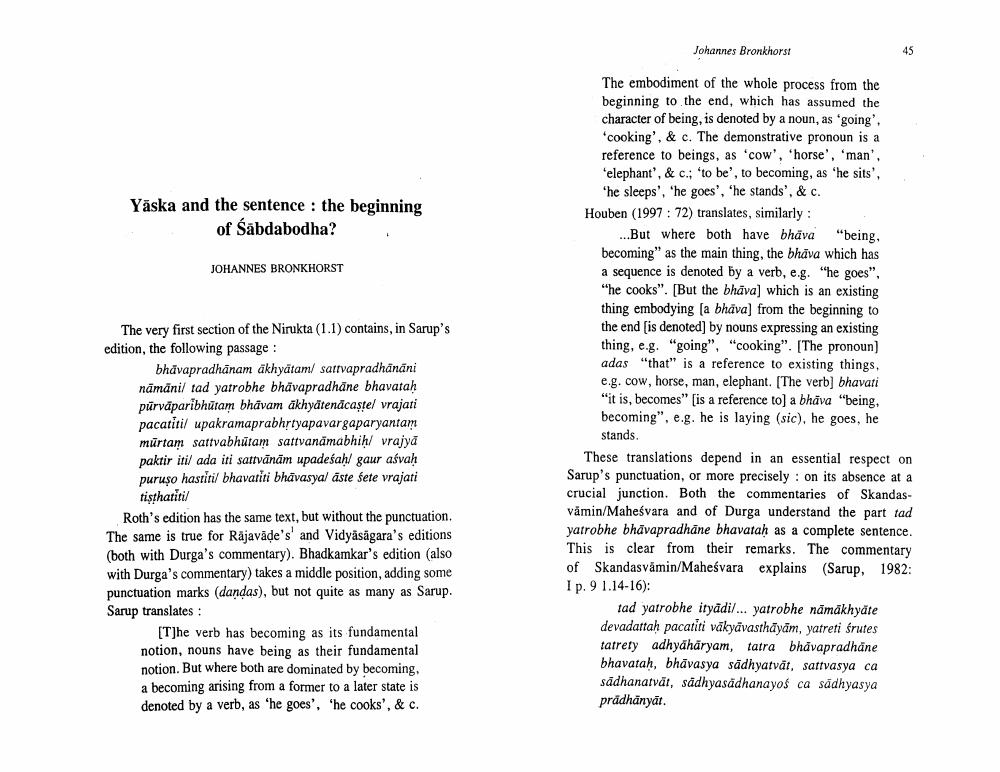Book Title: Yaska And Sentence Beginning Ofsabdabodha Author(s): Johannes Bronkhorst Publisher: Johannes Bronkhorst View full book textPage 1
________________ Johannes Bronkhorst Yaska and the sentence : the beginning of Sābdabodha? JOHANNES BRONKHORST The very first section of the Nirukta (1.1) contains, in Sarup's edition, the following passage: bhāvapradhanam ākhyātam/ sattvapradhānāni nāmāni/ tad yatrobhe bhāvapradhane bhavatah pürväparibhūtam bhavam ākhyatenacaste/ vrajati pacatitil upakramaprabhrtyapavargaparyantam mūrtam sattvabhūtam sattvanamabhih/ vrajya paktir itil ada iti sattvānām upadeśah/ gaur afvah puruso hastitil bhavatiti bhāvasyal áste sete vrajati tisthatitil Roth's edition has the same text, but without the punctuation. The same is true for Räjavāde's and Vidyasagara's editions (both with Durga's commentary). Bhadkamkar's edition (also with Durga's commentary) takes a middle position, adding some punctuation marks (dandas), but not quite as many as Sarup. Sarup translates : [T]he verb has becoming as its fundamental notion, nouns have being as their fundamental notion. But where both are dominated by becoming, a becoming arising from a former to a later state is denoted by a verb, as 'he goes', 'he cooks', &c. The embodiment of the whole process from the beginning to the end, which has assumed the character of being, is denoted by a noun, as 'going'. *cooking', & c. The demonstrative pronoun is a reference to beings, as 'cow', 'horse', 'man', -elephant', &c.; to be', to becoming, as the sits', 'he sleeps', 'he goes', 'he stands', &c. Houben (1997 : 72) translates, similarly : ...But where both have bhäva "being, becoming" as the main thing, the bhäva which has a sequence is denoted by a verb, e.g. "he goes", "he cooks". (But the bhäva] which is an existing thing embodying (a bhava) from the beginning to the end [is denoted] by nouns expressing an existing thing, e.g. "going", "cooking". [The pronoun) adas "that" is a reference to existing things. e.g. cow, horse, man, elephant. (The verb) bhavati "it is, becomes" [is a reference to a bhäva "being, becoming", e.g. he is laying (sic), he goes, he stands. These translations depend in an essential respect on Sarup's punctuation, or more precisely : on its absence at a crucial junction. Both the commentaries of Skandasvåmin/Maheśvara and of Durga understand the part tad yatrobhe bhävapradhane bhavatah as a complete sentence. This is clear from their remarks. The commentary of Skandasvămin/Maheśvara explains (Sarup, 1982: I p. 9 1.14-16): tad yatrobhe ityādi/... yatrobhe nämäkhyāte devadattah pacatiti väkyävasthāyām, yatreti frutes tatrety adhyāhāryam, tatra bhāvapradhane bhavarah, bhāvasya sādhyatvät, sattvasya ca sadhanatvät, sädhyasadhanayos ca sădhyasya prádhányāt.Page Navigation
1 2 3 4 5 6 7 8 9 10
